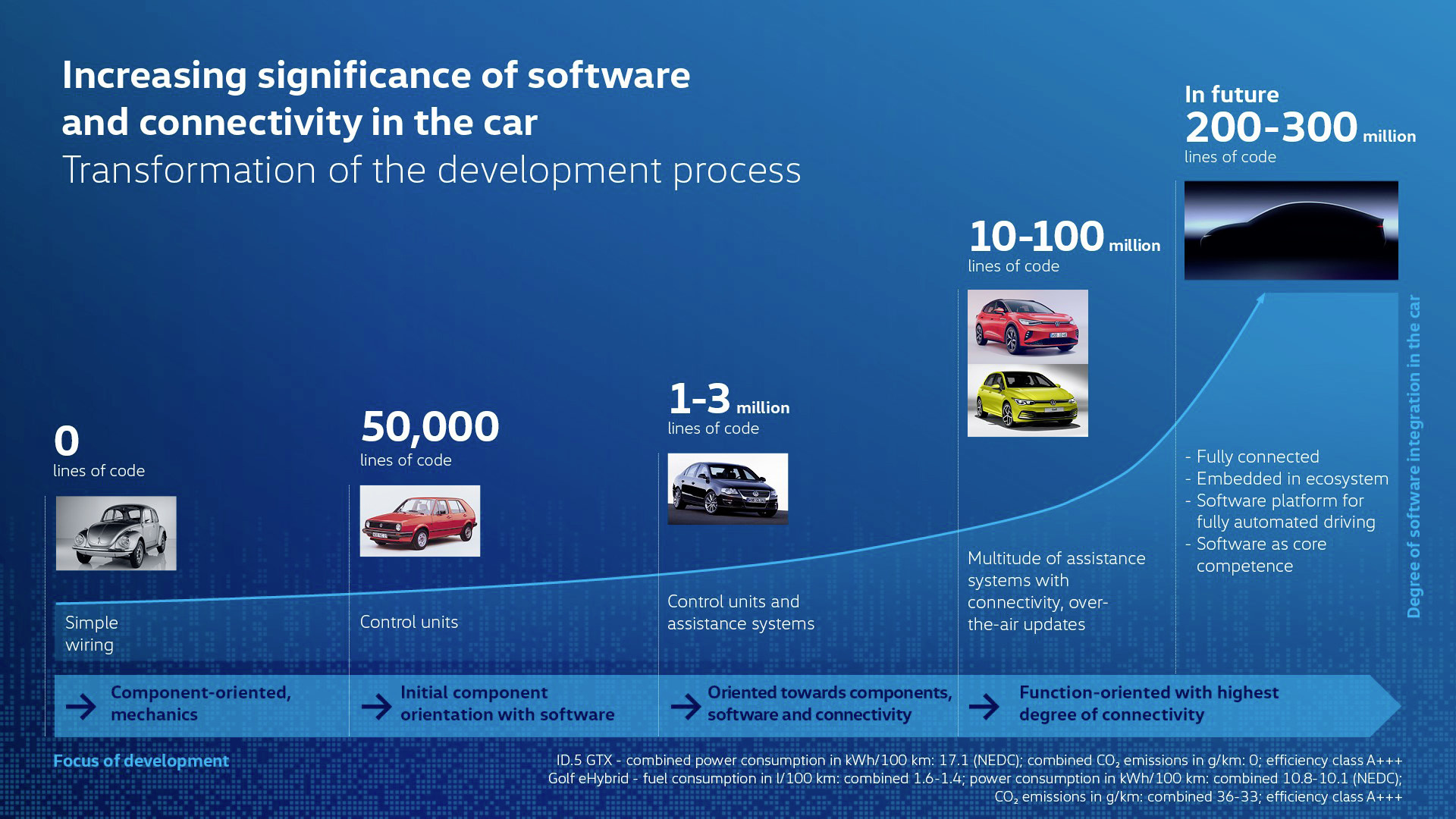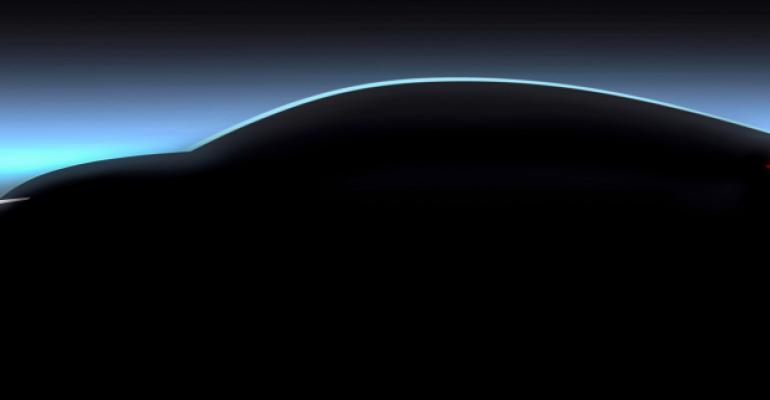The next phase of Volkswagen’s New Auto electric vehicle program will sire a direct rival to the Tesla Model 3, according to insiders familiar with the German automaker’s future model plans.
The 5-door liftback-style sedan, known internally under the internal working title Project Trinity, is planned to take the ID.4 name into production in 2026, pioneering a new product development process aimed at significantly reducing the overall development time of future VW models.
“We’re reducing development time by 25%,” says Thomas Ulbrich, Volkswagen’s head of R&D. “Future projects will be completed in 40 months from the point at which the basic software architecture is in place, instead of the 54 months we have today.”
While existing new-model development at VW has relied on individual engineering teams responsible for specific areas and components of each car – often in different locations in close consultation with outside suppliers and, in certain cases, without direct consultation with each other – the new process for the ID.4 sedan aims to promote a far more integrated and agile structure, Ulbrich reveals.
At the center of Volkswagen’s new development process, which is planned to be used on all upcoming ID. models, is a new upgradable software architecture called VW.OS.
“The car is increasingly becoming an electrically-driven software product. Its development process must also evolve, software first rather than hardware first,” says Ulbrich.
The new architecture, under development at CARIAD, the VW-owned automotive software and technology company, not only includes a proprietary operating system to be used by all VW models but also in-house-developed apps for various functions and services.
Volkswagen expects the proportion of software developed in-house for its future models to increase from under 10% today to more than 60% by 2025.
VW.OS is designed to support more than 200 million lines of software code, more than double the amount used by the existing MEB system.
Part of what Volkswagen Group CEO Herbert Diess describes as a “complete rethink” of the company’s operations, the new development process and VW.OS software architecture are intended to put Volkswagen on level footing with Tesla.
The U.S. BEV maker is “moving very fast, very focused. Twice as fast as the rest of the industry”, says Diess (pictured, below left).
 Many of the new processes being touted for the ID.4 were initiated by Audi for its similarly conceived Artemis project, which is meant to generate an even higher-positioned model slated for production in 2025.
Many of the new processes being touted for the ID.4 were initiated by Audi for its similarly conceived Artemis project, which is meant to generate an even higher-positioned model slated for production in 2025.
The ID.4 sedan will join a facelifted version of the ID.4 CUV in an expanded midrange lineup intended to provide competition to the Model 3 and its sister model, the Model Y.
It is planned to offer a choice of either single-motor rear- or dual-motor all-wheel drive and, from the beginning of sales, standard 5G OTA (over-the-air) software upgrades and Level 2 autonomous driving functionality.
VW originally suggested the ID.4 sedan would feature Level 4 autonomous driving functionality. However, it now says it will be technically capable of supporting it, if and when it is made available to customers.
Under the New Auto strategy announced last year, VW has switched its focus to the electrification of its model range with a goal to increase the electric model share of its global sales to 20% in 2025. In 2021, it was 6%.
Farther into the future, it anticipates electric models will take a 50% share of global sales by 2030 and an almost 100% share in all major markets by 2040.
The basis for the upcoming ID.4 sedan is VW’s new Scalable Systems Platform (SSP) – a skateboard-style architecture that Diess says will replace the existing Modularen Elektrik Baukasten (MEB) structure as well as both the J1 and Premium Platform Electric (PPE) platforms developed by VW-owned Audi and Porsche.
Other VW brands set to benefit from the new underpinnings include Lamborghini, SEAT, Škoda and International Scout.
“The next generation of our hardware platforms will allow us to reduce complexity over time as we will consolidate our existing platform to one architecture for the entire e-product portfolio, from entry-level to top-of-the-range, from 85 to 850kW,” Diess says.
Over its lifetime, the SSP platform is set to underpin more than 40 million vehicles, VW says.
While the MEB platform used by all of VW’s existing ID.-badged models use a 400V electric architecture, the SSP will be able to support systems at up to 800V. This will enable the automaker to offer the ID.4 sedan with a much high charging capacity than the 135kW of the recently upgraded ID.4 CUV, and with it significantly faster charging times on a high-powered DC system than those possible today. Nothing is official, though insiders talk about a reduction in charging time by a “factor of three.”

Details of the battery technology to be used by the ID.4 sedan are yet to be revealed. Sources suggest it will use cobalt-free chemistry similar to the lithium iron phosphorous (LFP) blade battery produced by Chinese automaker BYD. As with existing ID. models, the new VW model is expected to be offered with batteries boasting differing energy content and ranges.
VW indicates the most advanced ID. model yet will offer a range of up to 435 miles (700 km) on the European WLTP test cycle – more than 20% better than its existing electric models`. It also says the ID.4 sedan will be capable of accelerating from 0-62 mph (100 km/h) in less than 5.0 seconds.
The ID.4 takes full advantage of the SSP platform’s ability to site its battery on a flat floor with cab-forward proportions aimed at providing it with generous interior space.
The silhouette of the new liftback model has been revealed in photographs issued by VW.
With a length of about 181 ins. (4,600 mm), it is shorter than the ID.6 sedan – the upcoming production version of the ID. Vizzion – which is based on VW’s existing MEB platform and claimed to stretch to about 189 ins. (4,800 mm) long.
By comparison, the Tesla Model 3 is 185 ins. (4,694 mm) long.
Inside, the ID.4 sedan will offer seating for five as well as a rear luggage compartment.
The key new electric model will be produced starting in 2026 in a $2.15 billion (€2 billion) standalone factory close to Volkswagen’s traditional headquarters in the Warmenau district of Wolfsburg, Germany. Construction is set to begin in first-quarter 2023.
The new plant is designed to support a new modular production process that will allow the ID.4 sedan to be assembled in less than 10 hours, according to Diess, who has described it as VW’s answer to Tesla’s Gigfactories.
Similar plants using the same production processes and centered around new electric-powered SSP platform-based models, including the ID.4 sedan, are to be established in China in partnership with VW’s joint-venture partners FAW and SAIC.





